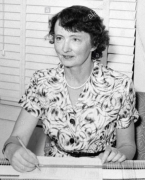Awards
- School of Optometry Foley House Basement Key Award - 1982

Ingeborg Schmidt was born in the village of Saddokul, near Tartu, Estonia. She completed medical studies at the University of Tartu in 1925 and practiced medicine for a short time in Estonia before beginning internships at various German hospitals. She received her doctorate in medicine in 1927 from the University of Tubingen.
She worked as a Research and Teaching Assistant in Professor W. Trendelenburg's laboratory at the Physiological Institute of the University of Berlin, at which time she published her first of 10 papers on color vision. By 1935, she obtained licensure in medical technology and in 1937 for the practice of medicine, in Germany.
From 1936 until the end of World War II, she served as both Assistant and Scientist in Dr. H. Strughold's laboratory at the Luftfahrtmedizinisches Forschungsinstitutut in Berlin. While there, she did further research in color and night vision. She also supervised the Central Library of Aviation Medicine, edited the Bibliography of Aviation Medicine and supervised medical students doing graduate research. Following Germany's surrender, she served six months at the Eye Hospital of the University of Goettingen and then as a Scientist at the Allied Air Forces Aeromedical Center in Heidelberg, Germany.
She entered the United States under a U.S.A.F. five-year contract as a Scientist at the School of Aviation Medicine, Randolph Field, Texas, and continued her research in color and night vision. She continued to publish her research and was responsible for four vision-related inventions. She was proficient in four languages: Russian, Estonian, German and English. From 1952 - 1953 she continued her research at the Knapp Memorial Foundation, Columbia University, New York.
Ingeborg Schmidt came to Indiana University in 1954 to start a new career as an Assistant Professor to develop and teach sensory physiological optics and ocular pathology courses in the new optometry program. Before then end of five years, she had advanced to full professorship and carved out for herself an international reputation in the new application of visual science to astronautics. She had predicted the visibility of artificial satellites to the unaided eye with such accuracy as to place her in demand as a consultant on other visual questions related to outer space and astronomy. As a result of her visual research, she was often called upon to evaluate visual problems related to automobile driving.
For ten years following her retirement in 1970, she continued her research, publications, and presentations at scientific meetings. and as the principle abstracter for the international color research newsletter Daltoniana. Her 73rd and final contribution was a paper presented at a symposium in London in 1979 which appeared as a chapter in Color Vision Deficiencies in 1980. As a result of her numerous honors and citations she was regarded by many as "the first lady of visual science." One of her discoveries, that of a genetic manifestation in carriers of color deficiency, is now referred to in the literature as the "Schmidt Sign."